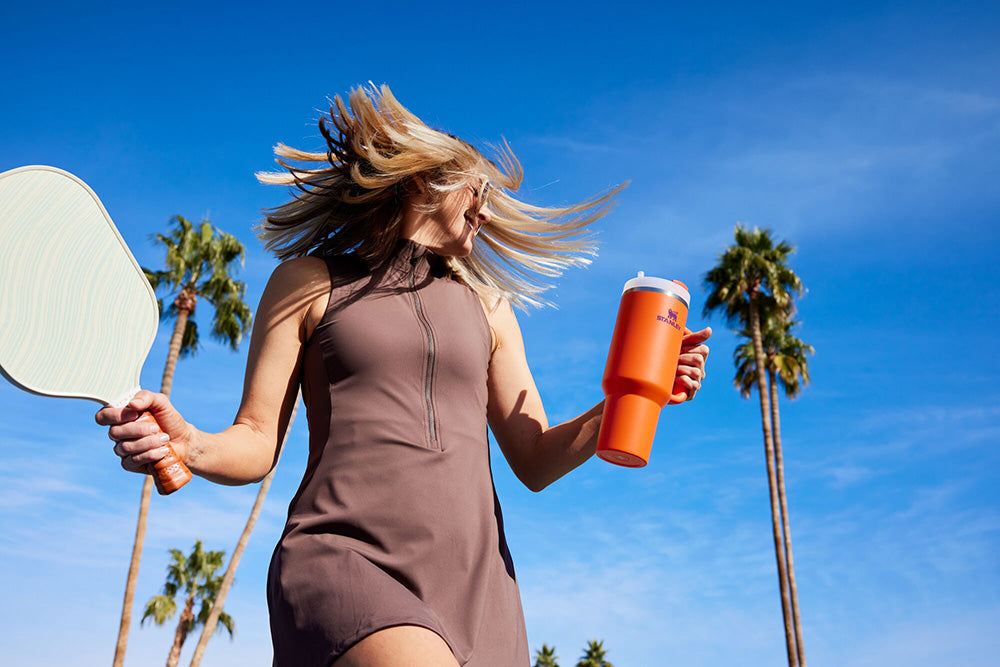Written By: Karla Tafra
Hydration needs noticeably increase once the weather becomes warmer. We move more, sweat more, and expend more energy, leaving us prone to dehydration and feeling thirsty. In order to prevent the negative side effects of dehydration, it’s important to find ways to stay on top of your hydration game. Here are some of the best tips to stay hydrated during the summer.
Importance of Hydration
Maintaining adequate fluid balance in the body is essential for optimizing your health and well-being. Water plays a critical role in regulating body temperature, and when the body becomes too hot, it produces sweat, which helps cool it down. However, if you're not properly hydrated, your body won't be able to produce enough sweat, which can lead to overheating and summer heat exhaustion.
Adequate water intake also helps to break down food and move it through the digestive system, support organ function, lubricate joints, transport nutrients and oxygen throughout the body, improve skin health, and boost athletic performance.
Overall, staying properly hydrated is important for maintaining good health and preventing a range of health issues. So, how much water is actually the right amount?
How Much Water Do You Need?
The golden rule of at least 8 cups (64 ounces) of water per day has long been dispelled, and the new recommendations look drastically different.
The U.S. National Academies of Sciences, Engineering, and Medicine recommend that men drink about 15.5 cups (3.7 liters) of fluids a day and women about 11.5 cups (2.7 liters) of fluids a day. This includes fluids from all sources, not just water. It's important to note that this recommendation includes water from beverages and food sources, as many foods contain water.
There is no one-size-fits-all, though, and these numbers can vary depending on factors like age, gender, activity level, climate, and overall health. Ultimately, it's crucial to listen to your body's signals for thirst and adjust your water intake accordingly. Additionally, factors like physical activity, sweating, hot weather conditions, illness, and pregnancy can increase your water needs.
Why Hydration Needs Increase In Summer
In order to prevent dehydration and ensure you’re drinking plenty of fluids, here are some helpful tips that can support your hydration goals during the summer:
-
- Take your water bottle with you: Keep your insulated water bottle with you at all times to ensure you’re able to sip throughout the day and to avoid long stretches without water.
- Eat hydrating foods: When it comes to water intake, everything counts. Fill your plates with hydrating foods and add a variety of health-boosting vitamins and minerals to your diet, including fruits.
- Set reminders: If you tend to forget to drink water, set reminders on your phone or use apps that can help you track your water intake and remind you to drink at regular intervals.
- Ensure you’re adequately hydrated before an activity or spending time outdoors: By staying prepared before an outdoor activity or a day spent tanning at the beach, you’re already one step ahead in preventing dehydration and having to “catch up” as you’re already sweating it out.
- Refill your water bottle: Look for sources for refilling your water bottle to make sure you’re always ready to sip.
- Consider electrolyte pouches: If you feel like your sweat rate has really gone up, you’re most likely losing precious electrolytes in addition to fluids. Mix a pouch of electrolytes into your beverage or sprinkle a dash of salt into your water in order to replenish.
- Avoid excessive caffeine and alcohol: Beverages like coffee, tea, and alcohol can have a diuretic effect, increasing fluid loss. If you consume these beverages, balance them with extra water intake.
- Seek shade and avoid excessive heat exposure: Minimize your exposure to extreme heat, especially during the hottest parts of the day. Seek shade, wear lightweight and breathable clothing, and use sunscreen to prevent overheating and excessive sweating.
- Keep your living and work environments cool: Use fans, air conditioning, or other cooling methods to maintain a comfortable temperature indoors, as excessive heat can contribute to dehydration.
- Monitor urine color: Keep an eye on the color of your urine. Pale yellow or straw-colored urine indicates adequate hydration, while darker urine suggests a need for more fluids.
- Be mindful of signs of dehydration: Learn to recognize the symptoms of dehydration, such as increased thirst, dry mouth, fatigue, dizziness, headache, or dark urine. If you experience these signs, prioritize hydration and seek shade or a cool environment.
Final Thoughts
Summer brings heat, outdoor activities, and a higher sweat rate, which increase your need for water intake. Still, individual hydration needs may vary, so it's important to listen to your body's signals and adjust your water intake accordingly. The goal is to prevent feeling thirsty, as that’s already a sign of dehydration, so your best bet is to carry your reusable water bottle with you no matter where you go. However, if you have any specific health conditions or concerns, it's always a good idea to consult with a healthcare professional for personalized advice.
ABOUT KARLA TAFRA
Karla Tafra, a Croatian content creator, yoga teacher, nutritionist, writer, and brand consultant, has been residing in the US for 7+ years. She has collaborated with various brands such as Nike, Gymshark, Adidas, Lululemon, Gaiam, Bodybuilding.com, Sakara Life, and W Hotels worldwide. Additionally, she served as the official off-season yoga teacher for the Seahawks and conducted health and wellness seminars in Facebook, Google, and Pinterest. Despite having a master's degree in law, her true passion lies in working with health and wellness brands that strive to enhance people's lives. She lives with her toddler in Bellevue, WA.
Back to HOW-TO GUIDES
















